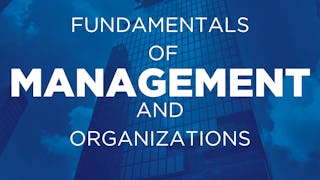This course provides an introduction to International Organizations and the United Nations, and explores how business and management tools can be applied in these settings to achieve better, more effective results. With a focus on cross-sector partnerships in a changing world, the course offers you insights into the inner workings of international organizations and the challenges they face today. It will introduce you to effective, state-of-the art management tools and principles to help you lead change in this world – taught by senior staff of international organizations themselves.



International Organizations Management



Instructors: Gilbert Probst
79,212 already enrolled
Included with
(2,013 reviews)
Skills you'll gain
Details to know

Add to your LinkedIn profile
6 assignments
See how employees at top companies are mastering in-demand skills

There are 6 modules in this course
Welcome to this course on International Organizations Management. Over the next five weeks, we will explore the inner workings of International Organizations and the United Nations and learn how business and management tools can be applied in these settings. The course is structured into five modules, each with a focus on a different aspect of international organizations, and includes lectures, discussions and readings to dive deeper into particular topics. To qualify for a course certificate, you must complete and score above 80% on all five of the end of module quizzes. See more details in the course syllabus below, then let's get started with Week 1!
What's included
1 video2 readings1 assignment1 discussion prompt
In the first module of our course on International Organizations Management, we provide an overview of the historical context and different ways of classifying international organizations in today's contemporary world. We will focus in particular on the United Nations – its origins, purposes, mandate, structure and activities – as the most important inter-governmental organization that coordinates global action on peace and security, humanitarian protection, human rights, and economic and social development.
What's included
9 videos5 readings1 assignment2 discussion prompts
In our second module, we will turn to the practice of international relations to understand how states engage with each other and other actors on the global stage. Today, international relations are about much more than the traditional study of states, security and power. From growing anti-trade sentiments, to the impact of climate change, to cyber-security in a hyper-connected world, most of the security threats of the 21st century will require greater cooperation across borders and collective action from governments, private sector and civil society. These shifts raise important questions for the future functioning of international organizations.
What's included
9 videos4 readings1 assignment
Now that you have a better understanding of the UN system, its shifting context, challenges and opportunities, we move on to explore the concept and practice of leadership in the UN. In this module, we will outline a conceptual framework and key literature on UN leadership. We explore different styles of leadership and examples of the practice of leadership by successive Secretaries General. We analyze several instruments of leadership – leadership through the power of convening, setting goals, marshalling evidence, and what we refer to as visionary leadership. We conclude by examining prospects for future UN leadership and multilateralism in a changing world.
What's included
12 videos5 readings1 assignment
The shifting context for international organizations makes collaboration on global challenges more important, but also more difficult. In addition to collaboration between nation states in traditional international organisations, public private partnerships (PPPs) have emerged as an innovative model for collaboration that transcends the conventional boundaries of the public sector, private sector and civil society. In this module, you will learn about the role of cross-sector partnerships in addressing today's complex challenges as well as the unique management approaches that are needed to bring diverse stakeholders together. We will set out theoretical frameworks to assess the opportunities and challenges of partnership, and apply these frameworks to examples of partnerships between international organisations and business, public agencies, and civil society.
What's included
9 videos6 readings1 assignment
International organizations are facing increasingly competitive environments in gaining the funding and public support necessary to fulfill their missions. The current economic situation has made it more critical than ever to use effective marketing management to build positive media attention and a strong brand identity. In this last module, we blend together theoretical principles with the practical skill of marketing and fundraising in international organizations. The course is divided into four parts, each with a theoretical framework followed by the application to a real world example.
What's included
9 videos4 readings1 assignment
Instructors



Offered by
Explore more from Leadership and Management
 Status: Preview
Status: PreviewUniversità Bocconi
 Status: Free Trial
Status: Free TrialUniversity of London
 Status: Free Trial
Status: Free TrialUniversity of Illinois Urbana-Champaign
 Status: Free Trial
Status: Free TrialFundação Instituto de Administração
Why people choose Coursera for their career




Learner reviews
2,013 reviews
- 5 stars
80.57%
- 4 stars
16.14%
- 3 stars
2.33%
- 2 stars
0.49%
- 1 star
0.44%
Showing 3 of 2013
Reviewed on Jan 23, 2025
What a great way to gain insight into the work and structure of international organizations. I'm even more motivated now than I was before to participate in these important missions.
Reviewed on Apr 22, 2023
Very useful course for those who want to learn more about how international organizations function. Even though I've worked for the UN for the past 6 years, I still found the content very useful.
Reviewed on Jul 26, 2023
This course has an upper hand on iOS operations.It makes me understand them.Thanks to Profesors who taught me.Will be able to apply the knowledge in day to day endeavors.

Open new doors with Coursera Plus
Unlimited access to 10,000+ world-class courses, hands-on projects, and job-ready certificate programs - all included in your subscription
Advance your career with an online degree
Earn a degree from world-class universities - 100% online
Join over 3,400 global companies that choose Coursera for Business
Upskill your employees to excel in the digital economy
Frequently asked questions
To access the course materials, assignments and to earn a Certificate, you will need to purchase the Certificate experience when you enroll in a course. You can try a Free Trial instead, or apply for Financial Aid. The course may offer 'Full Course, No Certificate' instead. This option lets you see all course materials, submit required assessments, and get a final grade. This also means that you will not be able to purchase a Certificate experience.
When you purchase a Certificate you get access to all course materials, including graded assignments. Upon completing the course, your electronic Certificate will be added to your Accomplishments page - from there, you can print your Certificate or add it to your LinkedIn profile.
Yes. In select learning programs, you can apply for financial aid or a scholarship if you can’t afford the enrollment fee. If fin aid or scholarship is available for your learning program selection, you’ll find a link to apply on the description page.
More questions
Financial aid available,






